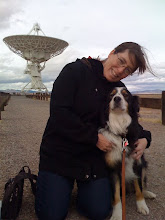Thinking up activities for the environmental physics class, that's what!
One of my goals for the class is to de-mystify power generation. I don't think you can reasonably talk about the physics of wind towers or solar panels without first having people understand how electricity is generated and used in the first place. Watch people do it in places like Nepal, and you feel empowered (ha!) to try it yourself.
So I want to have them experiment with rotation-style generators.
a) force them to wind their own coils, and use rare earth magnets to either light an LED, or simply make the ammeter move. This requires some experimentation on my part first. Also may require a 'materials fee', paid at the bookstore.
b) we have these hand-crank generators that will light a light bulb. It's a step up in 'black-box-ishness' from (a).
c) then a tiny wind tower. Er, I was wondering. If you took two box fans, and plugged one of them in, and pointed it at the 'out' of the other one, it should generate electricity, right? You wouldn't want to actually DO it this way, obviously, but I think it would be pretty educational, particularly if you measure the power into the plugged-in fan, and the power out of the other one. Again, I need to experiment, because I've never looked inside the motor of a box fan.
d) then paddle wheels. We'll make some, and then head up Strong's creek to drop them in the water. This is the way the Nepali's do it. They light their houses this way, charge batteries for cell phones, even run small refrigerators. Might be that we could build these out of Legos. Seriously.
e) then a steam driven 'turbine'. This has to be smaller, again, obviously. But it's a good analog for most of the power generation we do. I think it would be great to do this with a hotplate and a kettle and a turbine, and a generator, and a power meter at both ends. Why? It's a great way to measure efficiency!
f) a tour of the power plant down at Delta
But then we have the sun. This is a completely different way to do it. And it's why it's taking so long to 'go solar'. I'm not sure if they can make their own solar cells---I have to ask Colin. And I'm not sure exactly if that would help them understand the physical principles.
First, they should understand a few things about sunlight.
a) measure the insolation at ground level, compare to the insolation at the upper atmosphere. Figure out where the rest of it goes. For this, we need photometers... or cell phone cameras? A camera being basically a photometer... They'd need to calibrate against something they know the brightness of. Or we could do it the old-fashioned way, using inverse square law and your eye as a photometer. They should certainly be able to do this math.
b) measure the intensity of the focused sunlight at the focus of the radio telescope.
c) build a solar hot water heater.
d) build a solar oven.
by now, they'd be asking, 'but what about electricity!' But for a number of purposes, it doesn't make sense to take sunlight, turn it into electricity, and turn it into heat for a hot water heater, for example. But, for other things, it does.
e) perhaps make blackberry solar cells? I saw someone do this at ISU, in a couple of hours, but I'm not sure how much prep went in behind the scenes.
f) experiments with solar panels: Lego, (again, we can do efficiency measurements by lighting it with a light bulb and measuring inputs/outputs), or the sweet little ones you can use to charge your cell phone or iPod. These run ~ $30. Again, if I charge a materials fee, I can get one for each student that they can take home afterwards! Sneaky.
But it's not all about electricity, and I've just taken up something like 12 class periods just doing stuff about electricity.
I have only one idea so far about global warming, food production, transportation issues.
a) the 'classic' greenhouse experiment, with the CO2 filled tank, and the regular airfilled tank, and the lightbulbs and the thermometers. Which reminds me to try emptying one or a couple of the CO2 cartridges from my soda siphon into a fish tank, and see if that works as well as blocks of dry ice. It should, right? As long as you close the tank afterwards? Presumably, the CO2 diffuses out of there eventually, if it's an open tank, and that's why Adam uses the dry ice for the bubble tank...
more play is required on these topics...
Unforced variations: Jan 2026
15 hours ago

No comments:
Post a Comment